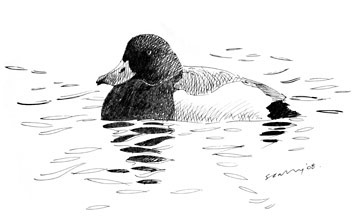Scaup (Aythya marila)

Scaup © Ray Scally
Scaup is the most marine of our diving duck, feeding mostly at night and often elusive even if encountered by day. Their diet is dominated by molluscs, but also includes dead fish and grain, which they obtain by diving, preferring water 6-12 m deep, but frequently reaching 30 m. They visit here mostly from breeding sites in Iceland, and the north Wirral has always seen most of the birds. A century ago, small numbers were found in winter in Liverpool Bay and the estuaries, mostly around the Dee mouth (Coward 1910). Bell (1962) wrote that the Scaup comes here annually but in variable numbers, and it is frequently found in small numbers at inland localities, mostly single birds but occasionally two, and rarely more than five together.
Large wintering flocks in the past have included 300 off West Kirby in 1938/ 39, and during the winters from 1946 to 1949 there were estimated to be 2,000 off Hoylake and Leasowe, and in early 1949 the numbers were nearer 5,000, but since then there do not appear to have been any comparable flocks (Bell 1962). For a while the flock on the Dee, mostly located between Caldy Blacks and Tanskey Rocks (SJ28E), was the only regular wintering haunt of Scaup in western England. The county bird reports note flocks of up to 300 or 400 from the 1960s into the 1980s, but their occurrence was erratic and in some winters there were very few. For instance, in early 1973 the maximum count was 15, leading the editor of the bird report to suggest that they may well disappear completely; but the next year there were up to 250 again. Numbers like this continued until 1983, then in 1984 ‘the winter flock off Caldy seems to have vanished’, but in 1985 there was an ‘exceptional’ influx of around 200 again, with over 400 in 1986. From the late 1980s the numbers dwindled to maxima below 100, and Hilbre became the most likely place from which to see the species. Counts have continued to decline, although with large annual fluctuations and occasional influxes such as 188 on 23 November 2001.
During this Atlas, the largest flock was counted at 47, with several gatherings of 25 birds, all found off the north or north-west of the Wirral, as far up the Dee as Dawpool Bank off Heswall (SJ28F) where 19 were on a Dee WeBS count. Elsewhere, there were up to four birds at Rostherne Mere in 2004/ 05, and one or two on all the other waters mapped.
Sponsored by Syngenta CTL

